Sleeper trains to the Alps
Travelling by sleeper train to the Alps means you sleep on the way and get extra time on the slopes. So what are your options?
-O%CC%88BB_Marek-Knopp-03crop960.jpg)
What are your sleeper train options?
Sleeper trains are having a renaissance in Europe. For skiers, they can be brilliant: sleep on your way to and from the slopes, adding two extra days' skiing to your holiday. Considering the benefits, there really should be more options. No doubt, in the coming years, there will be.
Currently, your two overnight options for travel between London and the Alps are:
- Eurostar + NightJet (to Austrian ski resorts)
- Eurostar + Intercités de Nuit (to French resorts)
Eurostar + Intercités de Nuit
 Daniel Elkan, Intercités de Nuit train
Daniel Elkan, Intercités de Nuit train
It was a brutal cull; 'trainocide', one could call it. In 2016, the French Government’s Ministry of Transport, which owns SNCF, decided to axe many sleeper train services all over France. In one fell swoop, several overnight train routes from Paris to the Alps disappeared despite their enduring popularity with skiers. Routes that had, for many years, trains running every night, now have zero overnight sleeper trains. What a shortsighted move by the French Government, or SNCF, or whoever is to blame. It's a huge loss for France, travellers and skiers - a move no doubt decided by accountants and spreadsheets, with no real comprehension of the bigger picture about how important overnight rail travel is.
Snowcarbon campaigned to keep these vital services running. Check out this two-minute film we made as part of the campaign: Save the Sleepers
The ski routes cancelled in 2016 were:
Paris - Moutiers, Aime, Landry and Bourg St Maurice
Paris - Annecy, Cluses, Sallanches and St Gervais
Resorts no longer served by these sleeper trains from Paris:
Avoriaz, Brides-les-Bains, Courchevel, Flaine, La Clusaz, La Plagne, La Rosiere, La Tania, Le Grand Bornand, Les Arcs, Les Carroz, Les Contamines, Les Gets, Les Menuires, Manigold, Megève, Meribel, Morillon, Morzine, Peisey-Vallandry, Sainte Foy, Samoens, Saint-Gervais, Saint-Martin-de-Belleville, Tignes, Val d'Isère, Val Thorens, and Valmorel.
The remaining routes are:
Paris - Briançon
Key resorts served: Montgenèvre, Serre Chevalier
Paris - Rodez/Latour-de-Carol
Key resorts served: (in Andorra) Pas de la Casa, Soldeu
Eurostar + NightJet to Austria
-ÖBB_Harald-Eisenberger-3crop960.jpg)
You can travel overnight from London to Austria's ski resorts. Your best option, which runs every night, is a combination of:
1. Eurostar from London to Brussels
2. Thalys or ICE from Brussels to Cologne
3. NightJet sleeper train from Cologne to the Tirol region of Austria
The NightJet, run by Austrian national operator ÖBB, has couchettes with flat beds so you can lie flat and enjoy a good night's sleep on your way to the slopes.
You can choose from sleeping in a 2-berth, 4-berth or 6-berth couchette compartment which can be shared or private.
Although the train has no cafe bar, the NightJet staff can give you a wake-up call accompanied by a complimentary continental breakfast brought to your couchette. You can also order hot and cold drinks and snacks at any time.
Find out more about travelling to Austria by sleeper train in our new section on London to Austria by Eurostar + NightJet.
What are couchettes like?
Reading in Intercités de Nuit couchetteDaniel Elkan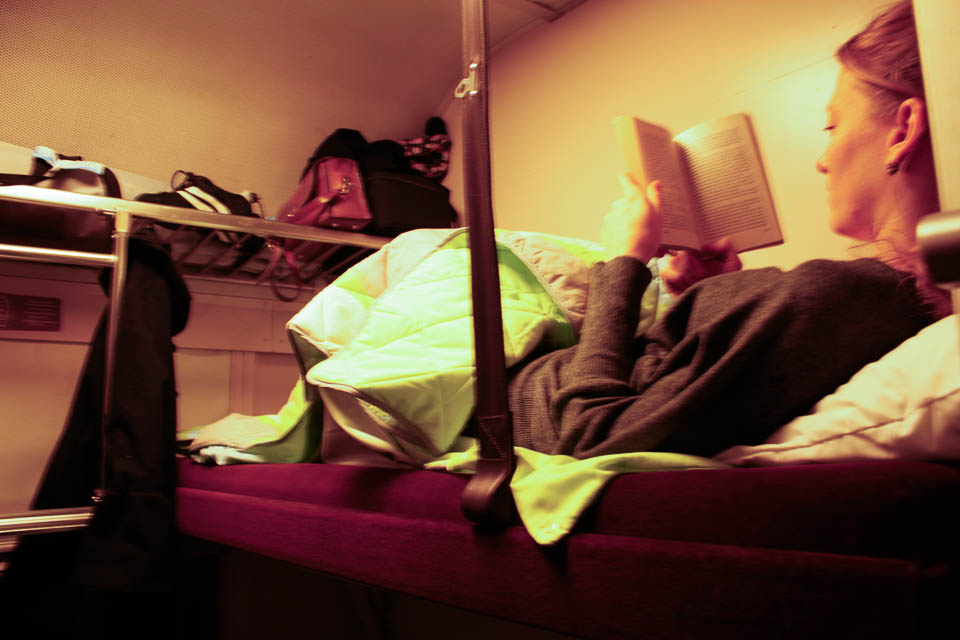
Couchettes are train compartments containing folding beds known as “berths”, with six or four berths in each couchette. You get freshly laundered sheets, a pillow, a quilt, and a small bottle of water. There’s a ceiling light and a reading light by each bed. The couchette door is lockable from the inside. Upper berths have straps to prevent you from rolling out of bed onto the floor.
In a 6-berth couchette, there’s not much space to move about once you've got your luggage in, but it's fine for banter and sleeping. You can also get 4-berth couchettes or (on Austrian trains) a more expensive two-berth (sometimes called a compartment)—particularly good for couples wanting a bit of privacy.
Couchettes are normally mixed-sex carriages, but you can request a single-sex couchette too. On most sleeper trains you can convert the couchette beds to seating in the morning.
Are you a night-train sleeper?
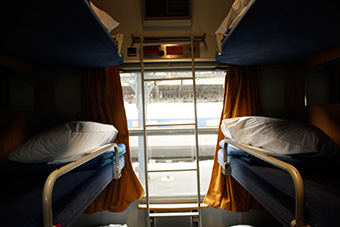
Having been on many overnight trains with different companions, we at Snowcarbon can safely say that most people sleep fine in a couchette, and the more you travel this way, the better you sleep.
The gentle rocking of the train can really help you nod off. Sometimes, sleeper trains pause during the night to regulate their timings, and if you aren't used to this you might wake up once or twice.
There’s usually a small bottle of still mineral water supplied with your berth, but it’s worth bringing an extra one so you don’t get thirsty. Wax earplugs, which you mould to the shape of your ear, are useful and available from most chemists.
While the Intercités de Nuit and NightJet certainly aren’t the Orient Express, it's great knowing you'll wake up in the Alps. Moreover, people normally sleep better the more often they take these trains, as the surroundings become more familiar.
If you’re considering the overnight Eurostar Snow service, be aware that it has no couchette beds, only reclining seats, which in our eyes is a big disadvantage. Many manage to sleep fine, but some don't. So balance this against the fact that it is direct—an obvious benefit in terms of simplicity. We also recommend reading travel blogger Stuart Jarvis' entertaining and informative account of what the overnight Eurostar Ski Train is like.
Luggage
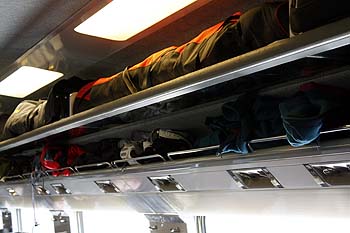
The Travelski Express has overhead racks for skis and space for luggage in special compartments at the end of each carriage.
On the sleeper train from Paris, in a six-berth couchette, the under-the-bed spaces will fit two snowboard bags or three pairs of skis each.
There is a large luggage space for bags behind the upper couchette beds and space on the floor in the middle of the compartment. If the couchette is full and everyone has big bags it can feel a little pushed for room, but it usually works out OK.
If you’re in a four-berth couchette, you’ll have even more space.
Reclining seats
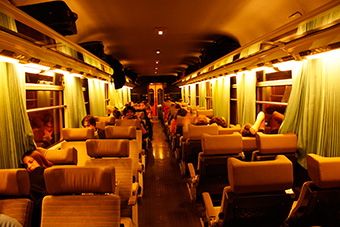
Most overnight trains have reclining seats as well as couchettes, but in the case of the overnight Travelski Express, reclining seats are your only option. Think carefully before you choose to travel this way – it isn’t as comfortable as a couchette and getting to sleep won’t be so easy.
Unlike a couchette, which is closed off by a door, reclining seats are located on either side of the train gangway, so people will be walking past you to go to the toilet etc.
Also, the lighting stays on in the reclining seat areas, so an eye mask helps.
Changing in Paris

The easiest way to change stations in Paris is with a pre-booked taxi. Your driver will meet you at the end of the Eurostar platform holding a sign with your name on it. This is available when you travel independently, but can also be requested as part of a rail-inclusive ski package.
If you haven’t booked, there’s a taxi rank at each train station in Paris, metres from the train platforms.
The Metro change from Paris Nord to Paris Austerlitz (where many Intercités de Nuit night trains depart from) requires going up and down several flights of stairs, so a taxi is much easier if you have luggage.
For more info, see our guides on how to change in Paris.
Extra time on the slopes
Overnight trains from Paris usually arrive in the Alps between 7 am and 10 am, and the direct Eurostar Ski Train arrives even earlier. If you are travelling independently, let your accommodation owner know your arrival time in advance, so that they can arrange a room where you can store your things while you go skiing and facilities to freshen up or shower on arrival. When you return in the afternoon you can check into your room.
On your final day, you’ll check out in the morning, store your things, and leave to ski. If you are in a chalet there may be some overlap with the next week’s guests arriving before you leave to catch the overnight train, but this shouldn’t be a problem. Have dinner in-resort or at the station before catching your overnight train.
If you fancy spending the Sunday of your return journey exploring Paris, Paris Austerlitz has shower and luggage storage facilities. You can then take the afternoon or evening Eurostar back to London.
Key questions for your chalet provider

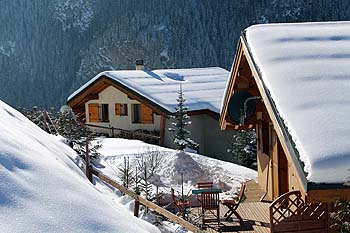
Many chalets, hotels or apartments will be used to skiers who fly, normally arriving late afternoon and departing in the morning a week later.
Travelling by overnight train means arriving in the morning and skiing the same day. However, there may be other guests (from the previous week) there when you arrive. So, here are seven key questions to check with your accommodation provider or tour operator before booking.
- Will our accommodation be open when we arrive in the morning?
- Can we get into the building to store our luggage securely and get changed into our ski clothes?
- Will other guests from the previous week still be there when we arrive?
- Can you pick us up from the station, and is there a charge for this?
- At what time will our rooms be available?
- Can you recommend anywhere for breakfast before we hit the slopes, or could you provide some breakfast?
- Can you arrange our lift passes in advance so we can head straight onto the slopes?
Answering these questions early should give you a smoother arrival and maximise your time on the slopes.
One-way overnight, one-way daytime
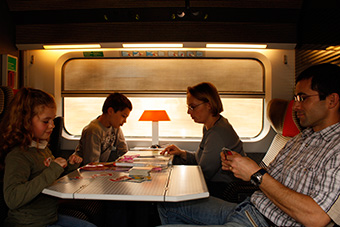
Many Alpine resorts are accessible by both daytime and overnight journeys, so an interesting option is to travel overnight outbound and travel daytime inbound, or vice versa.
Skiers often think of 'daytime' or 'overnight' train travel as an 'either/or', but as each has its advantages, it can be worth mixing them up into the same trip. You could also make one of the journeys a Paris stopover.
'Something for the weekend, Sir?' No, not really.
Sadly, since the 2016 cuts, the relative lack of weekday overnight rail options to French resorts means there are poor pickings if you want to use overnight rail for a ski weekend.
You could leave London on a Thursday evening, catch the overnight train from Paris and be on the slopes Friday morning. However, the way that SNCF has run this route in the 2017-18 season has been quite unpredictable, with services going on sale late and changes to the timetable to make the journey longer - not really viable for weekenders.
For weekend ski trips, where travel time is limited, you might find that flying is a more viable option.
Ski holidays by train — Ask Snowcarbon
At Snowcarbon we are always happy to help you with suggestions for great resorts, fantastic accommodations, and how to get there.
We look forward to helping you.


